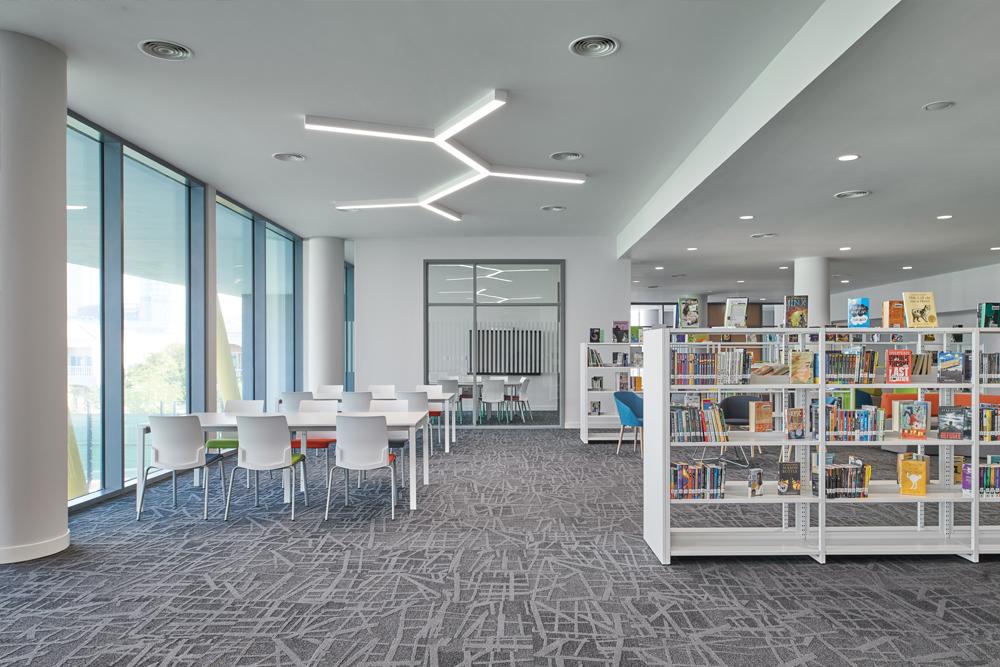DESIGNED as an educational facility for secondary grade students, The Arcadia Secondary School in Dubai is a purpose-built school adjacent to The Arcadia Preparatory School. The building, designed to accommodate up to 800 students, has most of its ground floor classrooms opening onto open protected spaces to the rear providing children with safe access to play areas from their classrooms. The campus covers a total teaching space of 6,000sq m, including the classrooms, shared learning, and labs. Other facilities in the campus include a library, music, and dance rooms that together cover an area of 1,500sq m.
Internally, classrooms are bright with ample daylight and with large corridors providing social spaces for children. Recreational play areas include a soccer pitch and sports courts, multipurpose hall and swimming pool are provided on different levels of the building.
The school is designed in line with sustainable building practices to provide an optimally safe, healthy, comfortable, and productive learning environment for students and a pleasant working environment for faculty and staff. Arcadia School is the second in a series of community-based schools delivering the vision of Mohan Valrani and the Al Shirawi Group.
The Arcadia School’s secondary campus is the second school designed and built by Godwin Austen Johnson Architects as part of a series of community-based schools for Arcadia Education. Located in Dubai’s Jumeirah Village Triangle, close to the primary school, the orientation of the new secondary campus and the functions within it have been optimised to exploit the view out over the central Jumeirah Village Triangle Park.
Drawing inspiration from The Arcadia School’s primary campus, the reception is bright and airy, opening out into a large casual seating zone with a unique 12m high indoor climbing wall feature. The new secondary school features a full sized artificial pitch, a 25m swimming pool and MUGA court, which can be accessed by the primary school when required.
This sharing of facilities also helps with the transition from primary to secondary education building confidence for the students about to move to the next stage of their education.
GAJ has been designing and building schools for many years and understand and value the opportunity to create unique buildings for school operators. Each one is tailored to the specific requirements and brand identity of the school. With this new school the team wanted to ensure brand consistency and a design approach to support the ethos and visual identity of Arcadia.
Jason Burnside, partner at Godwin Austen Johnson explains: ‘Owing to the limited site area we agreed with the client early in the design process that the central atrium needed to provide a focal point for the entire school. It needed to be more than just a simple entrance and more of a window into the school. As well as the operational functions of the reception, lobby and administration, the atrium focuses on a large vertical climbing wall and central atrium stair that doubles as a seating area for assemblies for students, staff, and parents.
‘Our main challenge was to overcome the single vehicular entry point permitted to the site.
Combined with the limited plot area and that the fact that the site was enclosed on three of the four sides we used a basement for staff parking and lifted the street side accommodation above the street level to the first floor which improves privacy for the classrooms but also allowed us to create a cover bus and car drop off and collection area.’
Commenting on the choice of materials and finishes used in the interior, Jason Burnside of Godwin Austen Johnson said: ‘Schools need to be robust and easy to maintain but to avoid a utilitarian design we wanted to create a strong connection with the palette of the junior school to create a warm and welcoming interior.
‘The choice of materials was critical to achieving the clients sustainability objectives so low VOC products were selected throughout with energy saving fittings installed where possible. Lots of natural light and acoustic wall and ceiling panels ensure high quality teaching environments.’
Continues the company: ‘Milliken’s Culture Canvas carpet tiles were chosen for the Arcadia School Library. With their tufted, textured surface they provide a luxury look and feel, while still giving all the practical benefits of carpet tiles. The design is inspired by street art and the layering of the spray-painted images on the concrete wall are re-graffitied on a nightly basis. Culture Canvas is produced in an ISO14001 certified facility in Wigan, UK using ethically sourced and wherever possible, locally produced, materials.’
It adds: ‘Culture Canvas carpet tiles feature 90% recycled content cushion backing offering underfoot comfort, improved acoustics and superior appearance retention leading to extended product life. To further reduce its environmental impact, Culture Canvas can be supplied with Milliken’s patented TractionBack, an innovative backing system that enables adhesive free installation and therefore improves indoor air quality, speeds installation, and reduces materials usage.
‘Culture Canvas is BRE certified, CRI Green Label Plus, GuT Certified and contributes to WELL points. Culture Canvas with TractionBack is eligible for LEED points.’
www.milliken.com


